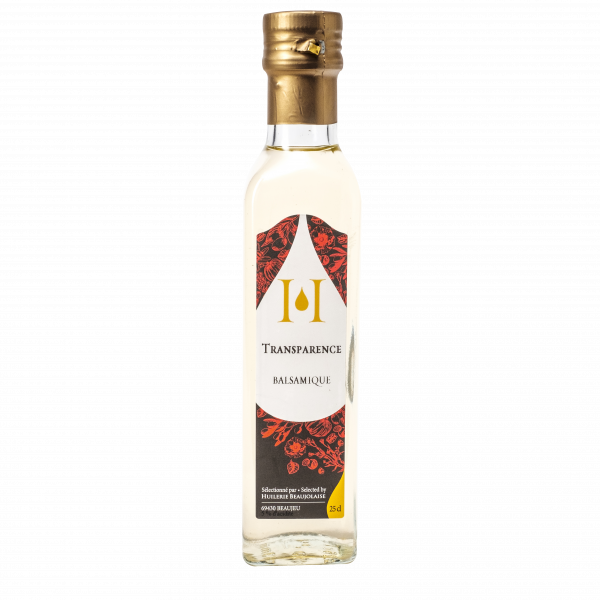
The Aromas of Transparence Balsamic Vinegar
Balsamic vinegar offers a sweet, complex, and slightly sugary flavor with balanced acidity. It provides a rich and nuanced range of flavors, including notes of ripe fruits such as plum, fig, and cherry. You can also detect hints of caramel or wood. These characteristics make it a highly appreciated ingredient for vinaigrettes, marinades, reductions, and even desserts.
The Making of Transparence Balsamic Vinegar
Balsamic vinegar is crafted from partially fermented grape must to which wine vinegar is added. After an acetification phase in noble wooden barrels, barrels, or tanks, it undergoes a maturation process. This maturation process, lasting a minimum of 60 days from the start of raw material processing, involves a meticulous blending of these components in the right proportions.
At the end of this period, the product undergoes analytical and organoleptic evaluation by a group of technical experts and tasters. This crucial step determines whether the product can be certified as Balsamic Vinegar. After 60 days of maturation in wooden tanks, Balsamic Vinegar of Modena can also be further aged. If this process extends beyond three years, the finished product is considered "aged." It can then be bottled for commercial sale.
Where Does Its Color Come From?
Transparent balsamic vinegar, also known as "white balsamic," is a newer variant of traditional balsamic vinegar, which is typically dark due to its extended aging in wooden barrels. Transparent balsamic vinegar is often made using the same production process but with light-colored grapes or grape must pressed directly without the skin. This gives it a lighter hue and a sweeter, more delicate flavor compared to traditional balsamic vinegar.
How to Use Transparence Balsamic Vinegar?
This vinegar pairs perfectly with salads, vegetable dishes, as well as meat and fish-based meals. You can experiment with it in different recipes to discover its range of flavors.
Some Suggestions for Using Transparence Balsamic Vinegar
- - Balsamic and Pepper Chicken: Once your chicken is cooked, in a skillet, add a knob of butter, then sauté two pears. Add balsamic vinegar and chicken broth. Bring to a boil, then simmer before adding your chicken.
- - Strawberries with Balsamic Vinegar: After preparing your strawberries, place them in a bowl and add red wine and balsamic vinegar. Let it rest and then serve.
- - Carrot and Zucchini Salad with Balsamic Vinegar: Once you've grated your carrots and zucchini into a bowl, add balsamic vinegar and olive oil to create a perfect vinaigrette.
- - Avocado Cream, Roast Chicken, and Balsamic Vinegar Toasts: Heat balsamic vinegar in a saucepan to form caramel. Let it cool, then blend an avocado to obtain a smooth texture. Add lime juice, salt, and pepper. Spread your bread slices with avocado cream, add pieces of chicken, and drizzle with your warm balsamic vinegar.
How to Store Balsamic Vinegar
It is best to store it in a cool, dry place, away from light, and at a temperature below 30°C (86°F).
| Price/kg | 0 |
|---|---|
| Allergen | Sulfites / Sulphites |
| Native country | ITALIE |
| Ingredients | balsamic vinegar (95%) (cooked grape must, wine vinegar (of which |
| SULPHITES)), cooked grape must (5%). | |
| Nutritional Info | VN Energie pour 100 g (energy for 100g) : 1444 kJ / 340 kcal VN Matière grasse (fat) : <0.1 g Dont acide gras saturés (of which saturated fat) : <0.1 g VN Glucides (carbohydrate) : 79 g Dont sucres (of which sugars) : 79 g VN Protéines (protein) : 0.9 g Vn Sel (salt) : 0.37 g |
| Contenance | 25cl |
 Français
Français 